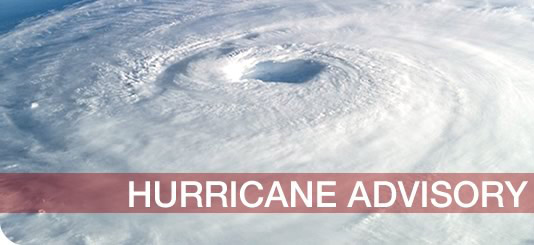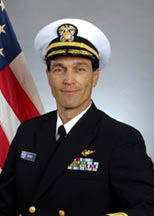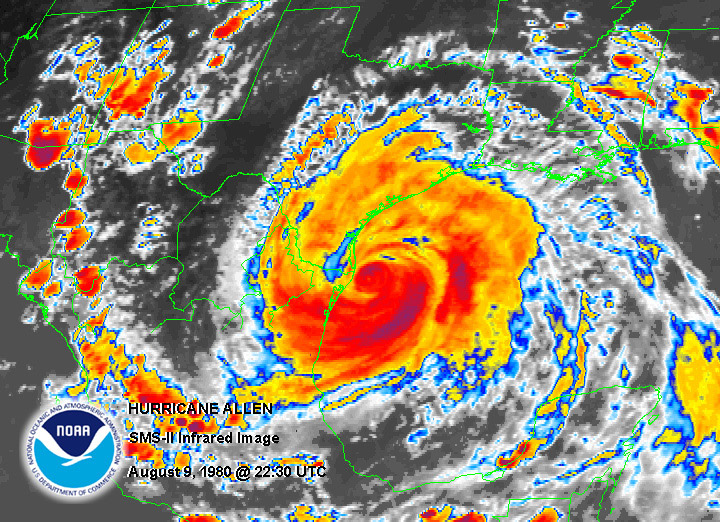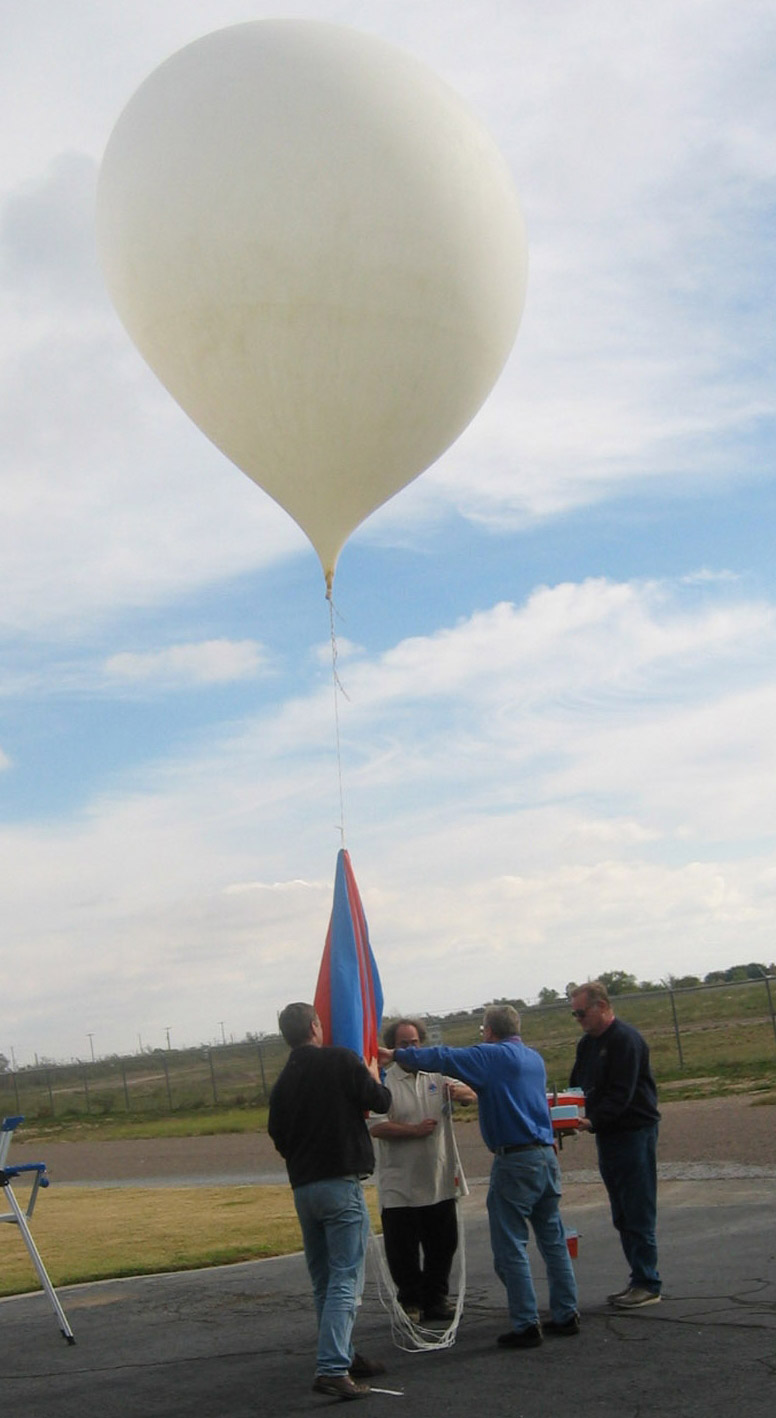Lesson: Weather Forecasting
(Weather Forecasting lesson provided courtesy of Teachengineering.org, with additional material from National Geographic, the National Oceanic and Atmospheric Administration and NASA.)
Summary
 Hurricane season is here, reminding us that accurate weather forecasts can be a matter of life and death in vulnerable coastal areas of the country. Even inland, severe thunderstorms play havoc with late-summer travel, and tornadoes threaten lives and property. In this lesson for grades 6 to 8, students begin by considering how weather forecasting plays an important part in their daily lives. They learn about the history of weather forecasting — from old weather proverbs to modern forecasting equipment — and how improvements in weather technology have saved lives by providing advance warning of natural disasters.
Hurricane season is here, reminding us that accurate weather forecasts can be a matter of life and death in vulnerable coastal areas of the country. Even inland, severe thunderstorms play havoc with late-summer travel, and tornadoes threaten lives and property. In this lesson for grades 6 to 8, students begin by considering how weather forecasting plays an important part in their daily lives. They learn about the history of weather forecasting — from old weather proverbs to modern forecasting equipment — and how improvements in weather technology have saved lives by providing advance warning of natural disasters.
Engineering Connection
People have forecast the weather since ancient times; however, thanks to the work of engineers over the past 100 years, we now have sophisticated weather forecasting equipment like weather balloons, satellites, Doppler radar and computer simulation programs. Today, people around the world rely on the information provided by these weather forecasting technologies, in the form of weather forecasts broadcast multiple times daily, to help choose what to wear, plant crops at the right time, and prevent natural disasters, such as hurricanes, floods and tornadoes.
Time Required: 20 minutes
Related Curriculum: subject areas Earth and Space, Science and Technology
Educational Standards
Next Generation Science Standards
- Obtain and combine information about ways individual communities use science ideas to protect the Earth’s resources and environment. (Grade 5)
International Technology and Engineering Educators Association
- New products and systems can be developed to solve problems or to help do things that could not be done without the help of technology. [Grades 6 – 8]
- Knowledge gained from other fields of study has a direct effect on the development of technological products and systems. [Grades 6 – 8]
Colorado Science Standard 5: Students know and understand interrelationships among science, technology, and human activity and how they can affect the world. (Grades 0 – 12) [1995]; 4.2: Students know and understand the general characteristics of the atmosphere and fundamental processes of weather. (Grades 0 – 12) [1995]
Click here and scroll down to “Educational Standards” to see if this lesson meets standards in your state.
Learning Objectives
After this lesson, students will be able to:
- Describe how weather forecasting has evolved from the observation of patterns to modern forecasting equipment.
- Explain how engineering advancements in weather forecasting improves the quality of people’s lives around the world.
- List several examples of technology behind modern forecasting equipment (weather balloons, satellites and weather radars).
Introduction/Motivation
What were you thinking about when you got dressed for school this morning? Specifically, how did you decide what to wear today? Did you glance out the window to see what the weather was doing? If you did look at the window this morning, what were your clues? (Possible answers: clouds, sunshine, wind blowing through the trees, birds in the sky, etc.) So, without even thinking about it this morning, you were forecasting the weather! Just as you did this morning, people around the world have been forecasting the weather for thousands of years. For a long time, people relied on weather patterns to predict the weather.
Who has heard the following expression? “Red skies in the morning, sailors take warning? Red skies at night, sailors’ delight.”
Well, although this rhyme is not entirely true, ancient sailors used it as a rule of thumb, due to the fact that a red morning sun did indeed often bring rain (because the red sky occurred when the air was full of dust and water vapor).
Besides sailors navigating on the open water and you wanting to dress right for the weather, why do we care about weather forecasting? (Note: Show students the weather section of the day’s newspaper.) Why is there a weather section in the newspaper? When you do see people consulting the weather forecast, either in the newspaper or on television? (Possible answers: before planning a trip, a sporting event, going on a picnic, etc.) What about people who grow food? Does anybody here have a garden at their house? It is certainly helpful to understand the weather when taking care of a garden.
 For farmers, whose crops are their livelihood, the ability to predict the weather is crucial. Before the advent of modern weather forecasting technology, which we will discuss later, how do you think farmers predicted the weather? (Note: If possible, show the students a copy of the Farmer’s Almanac.) Some of you may have heard of The Farmer’s Almanac, a book — used since 1792 — that uses a complex series of natural cycles to devise a secret weather forecasting formula, traditionally said to be 80% accurate. Before modern weather technology, farmers relied heavily on the Almanac to plan their crop growing seasons. People around the country still read the Almanac to learn about farming, the weather and to understand astronomical events and ocean tides.
For farmers, whose crops are their livelihood, the ability to predict the weather is crucial. Before the advent of modern weather forecasting technology, which we will discuss later, how do you think farmers predicted the weather? (Note: If possible, show the students a copy of the Farmer’s Almanac.) Some of you may have heard of The Farmer’s Almanac, a book — used since 1792 — that uses a complex series of natural cycles to devise a secret weather forecasting formula, traditionally said to be 80% accurate. Before modern weather technology, farmers relied heavily on the Almanac to plan their crop growing seasons. People around the country still read the Almanac to learn about farming, the weather and to understand astronomical events and ocean tides.
How do you think people forecast the weather today? (Possible answers: satellites, weather balloons, computers) Over the past100 years, engineers and scientists have worked to design modern forecasting equipment like weather balloons, satellites, Doppler radars, and more to help predict the weather. Fortunately, modern equipment has made it much easier to predict weather, climate and water-related hazards around the world, which account for nearly 90% of all natural disasters. Modern weather forecasting technology provides vital information for advance warnings of natural disasters like tornadoes, hurricanes and floods. Improved technology has saved many lives and reduced damage to property and the environment.
Lesson Background & Concepts for Teachers
History of Weather Forecasting
Humans have always attempted to predict the weather. In 650 B.C., people living in Babylonia, an ancient state in the southern part of Mesopotamia (modern day Iraq), predicted the weather from cloud patterns. The ancient Chinese predicted the weather by observing patterns of events. If the sunset was unusually red, it was often an indication of good weather for the following day.
Although these ancient methods of weather forecasting were used for centuries, they were not always reliable. Another limitation was that information about the current state of the weather could not be communicated to places far away. So, if a community of Babylonians were experiencing a terrible storm, they had no way to warn their neighbors downwind that trouble was coming!
The most basic weather forecasting is still based on the observation of weather patterns, which over the years has led to folklore about the weather. You are probably familiar with Groundhog Day, celebrated on February 2. This folklore originated from ancient Celtic people who believed that if the winter’s midpoint was sunny and clear, there would be a long, cold winter. In the Pennsylvania town of Punxsutawney, tradition holds that on the morning of February 2, a groundhog named Punxsutawney Phil leaves his home under the ground. If it is sunny and clear enough for little Punxsutawney Phil to “see his shadow,” a long winter is predicted. Unfortunately, this weather folklore is only accurate about half the time!
Modern Forecasting Equipment
Today, we rely on modern forecasting technology and engineering to predict weather patterns. The modern age of weather forecasting began with the invention of the telegraph in 1837, which allowed forecasts to be made by knowing what the weather conditions were like in distant places.
Even more progress was achieved during the 20th century, when engineers and scientists designed computers to make numerical weather predictions (computer simulations) of the atmosphere (see Figure 2). These simulations take information about the present weather and use the computational tools of physics and fluid dynamics to predict future atmospheric states.
Basically, the complicated equations used by the computer project how the working fluids of the atmosphere (i.e., wind and water) will change with different atmospheric conditions (i.e., temperature, humidity and pressure).
It is important to note that before any fancy computer simulations can be made, “raw” weather data (actual weather measurements) must be collected.
Two U.S. government agencies, the National Oceanic and Atmospheric Administration (NOAA) and the National Aeronautics and Space Administration (NASA) use computer models, satellites and aircraft to predict weather patterns.

- Rear Admiral Philip M. Kenul, an engineer, is in charge of NOAA ships and aircraft, including the “hurricane hunters.”
NOAA’s National Weather Service (NWS) is responsible for monitoring and forecasting severe weather events. They issue watches and warnings for tornadoes, flash floods, non-precipitation events (such as high wind warnings), severe thunderstorms, and flooding, as well as daily weather forecasts. They reach the public with these warnings mainly through NOAA weather radio and the Internet.
NASA assists NOAA with data gathered from satellites, a lightning ground-tracking network and unmanned vehicles that fly into storms.

- A NOAA image of Hurricane Allen, 1980.
Weather Balloons

- NOAA researchers prepare to release a weather balloon as part of an experiment.
Weather balloons are launched simultaneously twice a day from 900 locations around the world to obtain various types of weather data from the atmosphere. Weather balloons are made out of latex or neoprene (synthetic rubber) and have been engineered to withstand ice, rain, thunderstorms, very high winds, temperatures as cold as -95°C and air pressure 1,000 times less than what it is on Earth. These sturdy balloons carry an instrument called a radiosonde that measures pressure, temperature and relative humidity. Every two seconds, a transmitter on the radiosonde sends the data back to tracking equipment on Earth. Weather balloon technology had made it possible for us to retrieve important weather information in seconds, literally.
Satellite Technology
What about the big picture? Weather satellites are another engineering marvel that enable us to see what the Earth and clouds look like from space and give us a more comprehensive view of Earth’s interrelated systems and climate.
Weather Radars
What if we wanted to see inside a large cloud or storm to analyze its structure and gauge its potential to cause severe weather? Is this possible? Military radar operators asked this same question during World War II, when they noticed noise in returned radar echoes due to weather elements like rain, snow and sleet. When the war was over, many of these military radar operators became engineers to develop a use for the noisy echoes. Now, we have weather radar, a special type of radar that uses radio waves to “see” how precipitation is behaving in a cloud and how it might change.
RADAR stands for Radio Detection and Ranging. Basically, a radar is an electronic instrument used to determine the direction and distance of objects that reflect radio energy back to the radar site. Weather radars use radio waves to locate precipitation and determine its type (rain, snow, sleet or hail). They also calculate the motion of precipitation and forecast its future position and intensity.
All weather radars work by the process of scattering, where radiation energy is reflected by small particles, as shown in Figure 5. So, when weather radar sends a radar beam out into space, the precipitation particles in the atmosphere cause the radiation energy to scatter. The motion and behavior of the scattered radiation is read by the radar site and translated into important weather information.
The Doppler Radar
Most weather radars are Doppler radars, which can also detect the motion of rain droplets. Doppler radar gets its name from the Doppler Effect. Have you ever listened to an ambulance siren or a train whistle as it was coming toward you? You probably noticed that the pitch of the whistle changed as the train passed you and moved away. This change in the frequency of sound is called the Doppler Effect.
A Doppler radar measures the changes in the frequency of the signal it receives to detect the intensity of precipitation, estimate wind direction and speed, and predict hail size and rainfall amounts. Doppler radar gives forecasters the capability of providing early detection of severe thunderstorms that may bring strong damaging winds, large hail, heavy rain and possibly tornadoes.
Who Uses the Information?
We can certainly appreciate the staggering advances in weather forecasting equipment since the telegraph was used 100 years ago. What about the people who use the equipment? Who looks at all this weather data? Who checks to see if it makes sense?
One international organization is the World Meteorological Organization (WMO), an agency of the United Nations. WMO works to verify and standardize weather data and make it available to national meteorologists, local forecasters and other people interested in weather science and forecasting. This weather data is then put into maps by computers, which can make forecasts based on certain conditions and mark them on weather maps. Then, it is the meteorologist’s job to read and interpret these maps to make forecasts about the weather. You can obtain daily weather information for your city from the World Meteorological Organization by visiting http://worldweather.wmo.int/.
It is interesting to note that, according to NASA, the United States statistically has the world’s most violent weather. In a typical year, the U.S. will endure about 10,000 violent thunderstorms, 5,000 floods, 1,000 tornadoes, and several hurricanes. For this reason, improving weather prediction has been a high priority of meteorologists here for a very long time. Engineers and scientists will continue to work to improve weather forecasting technology to provide more accurate weather forecasts for the benefit of society, the economy and the environment.
Vocabulary/Definitions
Doppler Effect: The change in frequency of a wave (i.e., a sound wave) perceived by an observer moving relative to the source of waves.
Meteorologist: A person who uses scientific principles to explain, understand, observe or forecast the Earth’s atmospheric phenomena and/or how the atmosphere effects the Earth and life on the planet.
Radar: An electronic instrument used to determine the direction and distance of objects that reflect radio energy back to the radar site.
Satellite: Any object that has been put into orbit by human endeavor.
Scattering: The process by which radiation energy is reflected by small particles.
Weather Balloon: A durable helium — or hydrogen — filled balloon which carries instruments to obtain information about atmospheric conditions.
Weather Satellite: A type of satellite used to monitor the weather and climate of the Earth.
Associated Activities
Backyard Weather Station – In this activity, students use their senses to describe what the weather is doing and to predict what it might do next.
Lesson Closure
Now that we have learned how weather forecasting has come a long way from the basic observation of weather patterns, we can appreciate the work of engineers who have worked so hard to develop modern forecasting equipment. Advanced technology like weather balloons, satellites and Doppler radars have improved the quality of people’s lives around the world by helping us plan our days, plant our crops, and prepare for natural disasters, such as hurricanes, tornadoes and floods.
Attachments
Cool Weather Forecasting Facts Worksheet (doc)
Cool Weather Forecasting Facts Worksheet (pdf)
Cool Weather Forecasting Facts – Answer Key (doc)
Cool Weather Forecasting Facts – Answer Key (pdf)
Assessment
Pre-Lesson Assessment
Weather Proverbs: Read the following list of weather proverbs to the students. In small groups or as a class, try to guess what each weather proverb means and what it might tell us about the weather.
If crows fly low, winds going to blow; if crows fly high, winds going to die.
No weather is ill if the wind is still.
News and weather….they travel together.
A sunshiny shower won’t last half an hour.
Clear moon, frost soon.
From twelve ’til two tells what the day will do.
It rains as long as it takes rain to come.
When sea birds fly to land there truly is a storm at hand.
Post-Introduction Assessment
Cool Weather Forecasting Facts: Before the lesson introduction, give each student a copy of the attached Cool Weather Forecasting Facts Worksheet. Have the students take notes while listening to the introduction and lesson (using the information from the lesson background section). At the end of lesson, have students share their cool weather forecasting facts with the class. This worksheet can also be used as a lesson organizer.
Lesson Summary Assessment
Explaining Weather Proverbs: Return to the list of weather proverbs listed in the Pre-Lesson Assessment. Now have the students explain how they could test these proverbs. What forecasting equipment could the students use to determine if the proverbs are true?
Lesson Extension Activities
Understanding the Doppler Effect: This activity can be used as a demonstration to teach students how the Doppler Effect works and how Doppler radar helps meteorologists predict the weather.
You will need:
Battery powered razor or horn (something with a steady tone)
Cassette recorder with a microphone
Procedure:
- Record the sound of the razor or horn.
- Play the recording to make sure it sounds exactly like the original sound.
- Record the razor or horn again. This time, move the razor or horn towards and past the microphone several times.
- Play the recording back and listen to the pitch of the razor or horn go up as it gets closer to the microphone and go down as it moves further away.
Explanation: The change in the frequency of sound is called the Doppler Effect. Doppler radar measures the changes in the frequency of the signal it receives to detect the intensity of precipitation, estimate wind direction and speed, and predict hail size and rainfall amounts.
Video: Launch of a weather satellite.
Related Lesson: Hurricanes (Teachengineering.org)
Filed under: Class Activities, Grades 6-8, Grades 6-8, Grades K-5, Lesson Plans
Tags: Environmental Engineering, Research on Learning, Technology for Learning, Wind Technology








